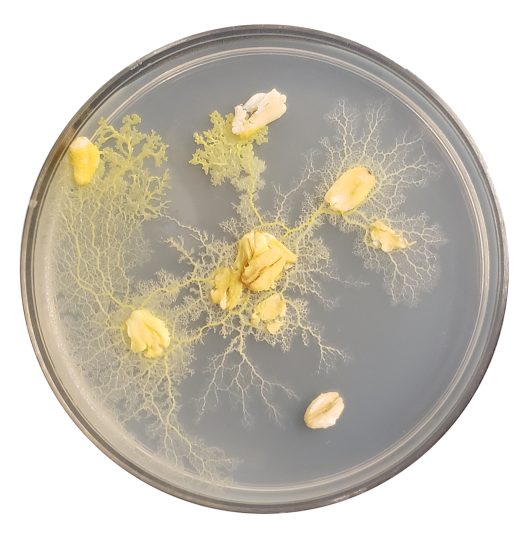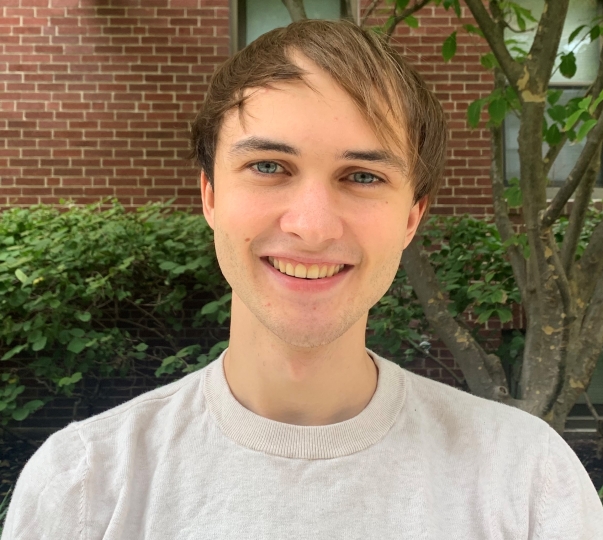Dionne's undergraduate research examined how the slime mold Physarum polycephalum
Max Prigozhin didn’t know what to think when he saw Adam Dionne’s undergraduate thesis research. Dionne had spent his senior year at Williams College in western Massachusetts studying a slime mold called Physarum polycephalum, and sent along images of his research in his application to join Prigozhin’s biophysics lab at Harvard.
“I remember asking myself, is this some sort of a cryptic sign on a tomb of an Egyptian pharaoh? Is this a map from a video game? Is this a landscape of a Martian desert?” said Prigozhin, Assistant Professor of Molecular and Cellular Biology and of Applied Physics at the Harvard John A. Paulson School of Engineering and Applied Sciences (SEAS). “It was so weird and unusual, so I called up Adam to chat with him about his work, and that’s how it all started.”
Dionne is now a first-year Ph.D. candidate in applied physics in Prigozhin’s lab. His first semester at SEAS and the Harvard Graduate School of Arts and Sciences began on a high note, as his undergraduate research was selected for the prestigious Leroy Apker Award. Presented annually by the American Physical Society, the award recognizes one undergraduate student from a non-Ph.D. granting institution – like Williams – and one from a Ph.D. granting institution for outstanding achievements in physics.
Over the summer, Dionne presented his work to a panel of judges at the American Physical Society. “What was very novel about it was talking so intimately with leading, cutting-edge physicists who are very experienced and have been doing research for decades, and having them so interested in my work and talking back and forth almost more like colleagues,” Dionne said.
Dionne studied the processes by which Physarum polycephalum forages for and then distributes nutrients throughout its system. Biological organisms larger than a cell need an active transport process for nutrients, such as the human vascular system that pumps blood throughout the body. The human vascular system also uses a central organ, the heart, to power the entire process.
Physarum polycephalum doesn’t have a centralized organ. Dionne and his advisors, Henrik Ronellenfitsch and Katharine Jensen, studied how the slime mold self-organizes a decentralized way to transport nutrients through a series of tubes, each of which pumps on its own.
“I found the organism incredibly interesting,” Dionne said. “It was so simple. It had no nervous system. It was single-cellular but spanned the size of a petri dish. Before the research, I’d worked on math, physics, and some computer science. This project really leverages all of those tools to study a very interesting biological system, so it was very fun work for me.”
Adam Dionne, Ph.D. candidate in applied physics
Dionne’s undergraduate research drew on multiple scientific and mathematical disciplines, and required a range of theoretical, computational and experimental skills. That multidisciplinary approach is part of what brought him to Harvard and the Prigozhin Group in particular.
“Max’s lab and all of his lab members, they are all phenomenal people who were obviously high-quality scientists impassioned by their work,” Dionne said. “I love the fact that his lab is not just 10 physicists. It has physicists, mathematicians, bioengineers, electrical engineers – a whole diverse skill set that you can tap into to try to solve these really challenging problems.”
These days, Dionne is studying how cells incorporate external signals using proteins called G protein coupled receptors (GPCRs), which are located on external cellular membranes.
“The dynamics of GPCRs evolve over time when they get stimulated by a signaling molecule. These dynamics have existed in a blind spot for biologists because it’s a very small protein and a very fast process,” Dionne said. “That’s very difficult to probe, so Max has been developing a novel biophysical tool that lets you probe this regime of small, fast dynamics.”
Prigozhin’s tool utilizes a process called cryo-vitrification, which freezes the cell at a specific moment after stimulation. With enough frozen cells, it becomes possible to see the entirety of the cell signaling cycle.
“We’re creating a flipbook of cellular signaling that you want to be able to put back together and analyze,” Dionne said. “It’s a pretty natural next step in taking the two parts I was doing in my undergraduate work and really advancing them. I was doing computational work, and I was doing light experimental work, and I’m ramping up both areas and applying it to a more challenging problem that’s very impactful. It’s a really enjoyable process of getting really in depth in both areas and leveraging my past experiences.”
As a first-year Ph.D. student, Dionne knows he’s just beginning to experience everything SEAS and Harvard have to offer.
“Adam is a very promising young physicist,” Prigozhin said. “He has a unique skill set that combines deep biological understanding with rigorous mathematical modeling. In my group, Adam is building on his theory skills, while also supplementing them with the knowledge of biophysical instrumentation and measurement – a powerful combination of expertise that will allow Adam to address central questions in biophysics and, hopefully, serve as a launchpad for Adam’s future career in science.”
Press Contact
Matt Goisman | mgoisman@g.harvard.edu

